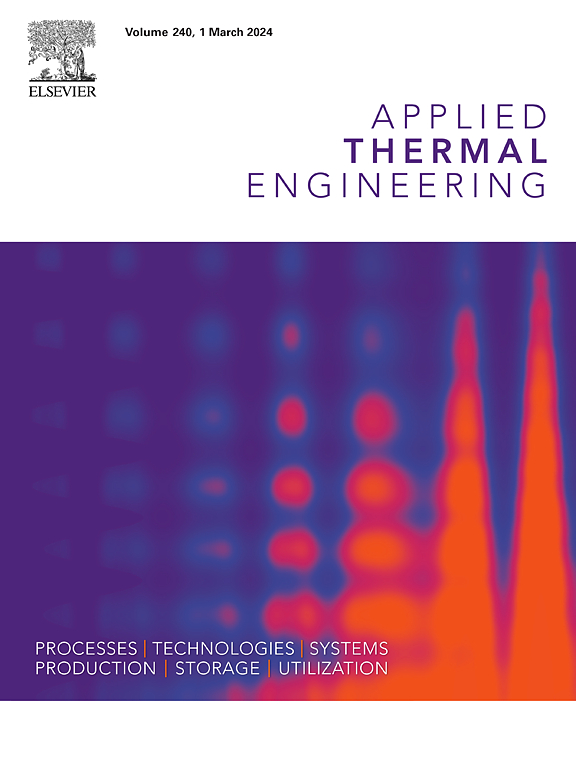Enhancement of film cooling effectiveness fed by internal crossflow using inlet expansion standard shaped hole
IF 6.1
2区 工程技术
Q2 ENERGY & FUELS
引用次数: 0
Abstract
Recent efforts have highlighted asymmetric and deteriorated coolant distribution behind crossflow-fed shaped holes, primarily due to in-hole vortical structures. In this study, inlet-expansion standard-shaped hole (IESSH) is proposed and investigated using large eddy simulation at channel-to-mainstream velocity ratio of = 0.3–––0.7, coolant-to-mainstream velocity ratio of = 0.4–––1.2, and corresponding inlet velocity (channel-to-coolant) ratio of = 0.15–––1.75. Results show significant performance improvements for inlet-expansion at the windward, leeward, and forward hole edges. While the standard shaped hole serves as the baseline with degraded and biased coolant distribution, the IESSH design demonstrates symmetric coolant spreading and higher effectiveness. Specifically, the IESSH design exhibits wider and stronger vorticity at the entrance, enhancing coolant ingestion from both top and bottom channel flows, particularly at lower inlet velocities. Higher values lead to lower discharge coefficients, resulting in insufficient coolant and reduced effectiveness, whereas lower values feature higher discharge coefficients, improving coolant distribution. Notably, the IESSH design consistently shows higher discharge coefficients and cooling effectiveness, especially in transition and mixing regimes ( > 0.45). An operating range of 0.4 < < 1.5 is recommended for efficient performance, where the IESSH leverages enhanced coolant momentum. Very low ( < 0.25) values can lead to inefficiencies due to higher momentum and coolant lift-off. The findings provide valuable insights into the relationship between hole-inlet geometrical configurations and flow conditions, promoting advancements in cooling technology.
利用入口膨胀标准形孔提高内部横流送入的薄膜冷却效果
最近的研究强调了横流馈送型孔后冷却剂分布的不对称和恶化,主要是由于孔内的螺旋结构。在本研究中,采用大涡模拟的方法提出并研究了入口膨胀标准形孔(IESSH),通道与主流速度比VRch = 0.3—0.7,冷却剂与主流速度比VRc = 0.4—1.2,相应的入口速度(通道与冷却剂)比VRin = 0.15—1.75。结果表明,在迎风、背风和前方的孔边缘处,进气道膨胀的性能得到了显著改善。虽然标准形孔是冷却剂分布退化和偏置的基准,但IESSH设计显示了对称的冷却剂分布和更高的效率。具体来说,IESSH设计在入口处表现出更宽、更强的涡度,增加了顶部和底部通道流动的冷却剂摄入,特别是在较低的进口速度下。VRin值越高,排放系数越低,冷却剂不足,效率降低;VRin值越低,排放系数越高,冷却剂分布越好。值得注意的是,IESSH设计始终显示出更高的排放系数和冷却效率,特别是在过渡和混合制度(VRin >;0.45)。工作范围:0.4 <;VRin & lt;1.5推荐高效性能,其中IESSH利用增强的冷却剂动量。非常低的VRin (VRin <;0.25)的值可能会导致效率低下,因为更高的动量和冷却剂的上升。这一发现为研究进口孔几何结构与流动条件之间的关系提供了有价值的见解,促进了冷却技术的进步。
本文章由计算机程序翻译,如有差异,请以英文原文为准。
求助全文
约1分钟内获得全文
求助全文
来源期刊

Applied Thermal Engineering
工程技术-工程:机械
CiteScore
11.30
自引率
15.60%
发文量
1474
审稿时长
57 days
期刊介绍:
Applied Thermal Engineering disseminates novel research related to the design, development and demonstration of components, devices, equipment, technologies and systems involving thermal processes for the production, storage, utilization and conservation of energy, with a focus on engineering application.
The journal publishes high-quality and high-impact Original Research Articles, Review Articles, Short Communications and Letters to the Editor on cutting-edge innovations in research, and recent advances or issues of interest to the thermal engineering community.
 求助内容:
求助内容: 应助结果提醒方式:
应助结果提醒方式:


